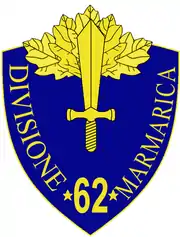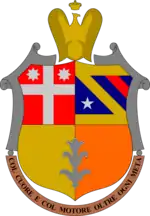62nd Infantry Division Marmarica
The 62nd Infantry Division Marmarica was an auto-transportable Infantry Division of the Italian Army during World War II. IT was formed 9 May 1937 in Derna, Libya and was destroyed 5 January 1941 in Bardia. The Marmarica was classified as an auto-transportable division, meaning staff and equipment could be transported on cars and trucks, although not simultaneously.
| 62nd Infantry Division Marmarica | |
|---|---|
 62nd Infantry Division Marmarica Insignia | |
| Active | 1939–1941 |
| Country | Italy |
| Branch | Italian Army |
| Type | Infantry |
| Size | Division (Italian infantry divisions had at full strength about 13,000 men.) |
| Nickname(s) | Marmarica |
| Engagements | World War II |
| Insignia | |
| Identification symbol | |
Action


The Marmarica Division was mobilized in October 1939. By 10 June 1940 it was re-located to Bardia. From 14 June 1940 to 23 July 190 it was used to attack Fort Capuzzo on the hills south of Saqīfat az Za‘farānah. 9 September 1940 the division Marmarica has arrived to Egypt to participate in the Italian invasion of Egypt.[1] The Marmarica intended role was to protect the right (inland) flank of the advance to Sidi Barrani. (Operation Compass). 13 September 1940, the division passed the Halfaya Pass, and soon the orders were received to stop and prepare for the defence. The Operation Compass, started 18 November 1940, have cut the division from the bulk of the Axis forces. At Battle of Marmarica start 11 December 1940, the division was located at Sidi Omar to the south of Sollum. In the first day of fighting it became obvious that the Marmarica positions were untenable, therefore the retreat was made to stronghold of Bardia-Abyār ar Rujm - Zawiyat al Manestir - Bi’r al Ghirrīdīyah. The Marmarica had settled on the new defensive positions 16 December 1940. On 3 January 1941, the British resumed the offensive, resulting in Battle of Bardia.[2] As the Allied forces advanced, several large Italian units were surrounded, cut off from supply, and defeated. After some hard fighting, one position after another surrendered. The Australians captured Bardia on 5 January, taking 36,000 prisoners[3] and 462 guns[4] for a loss of 130 dead and 326 wounded of their own.[5][6] Whenever the Italians choose to fight, the fighting was fierce. An Australian historian later wrote that "in parts their defence was most efficient and often extremely brave."[7] But the majority of Italian units surrendered without fight, their morale sapped by hunger, thirst, lice and dysentery.
Order of battle
- 115. Infantry Regiment
- 116. Infantry Regiment
- 44. Motorized Artillery Regiment
- 1. Motorized AA battery 20 mm (8 guns)
- 2. Motorized AA battery 20 mm (8 guns)
- 3. Artillery battalion (12 guns Cannone da 75/27 modello 11)
- 4. Artillery battalion (12 guns Cannone da 75/27 modello 11)
- 5. Artillery battalion (12 guns Obice da 100/17 modello 14)
- 62. Engineer Battalion
- 62. Machine Gun Battalion [nb 1]
- Training battalion
- Tankette battalion
- Motorcycle company
- 62a Anti-tank gun company 47/32
Notes
- Footnotes An Italian infantry division at full strength had about 13,000 men
- An Italian Infantry Division normally consisted of two Infantry Regiments (three Battalions each), an Artillery Regiment, a Mortar Battalion (two companies), an Anti Tank Company, a Blackshirt Legion of two Battalions was sometimes attached. Each Division had only about 7,000 men, The Infantry and Artillery Regiments contained 1,650 men, the Blackshirt Legion 1,200, each company 150 men.[8]
- Citations
- http://www.regioesercito.it/reparti/fanteria/rediv62.htm
- Mead, p 332
- Wavell in "No. 37628". The London Gazette (Supplement). 25 June 1946. p. 3265.
- Churchill 1949, p. 616
- "Bardia & Excuses". Time Magazine (6 January 1941). 6 January 1941. Archived from the original on 3 December 2007. Retrieved 17 December 2007.
- Latimer, p. 54.
- Baker, Kevin (2005). Paul Cullen, Citizen and Soldier: The Life And Times of Major-General Paul Cullen. Dural, N.S.W.: Rosenberg. ISBN 1-877058-28-9., p. 56
- Paoletti, p 170
References
- Churchill, Winston (1949). Volume 2: Their Finest Hour. The Second World War (1st ed.). Houghton Mifflin Company.
- Latimer, Jon (2000). Operation Compass 1940: Wavell's Whirlwind Offensive. Oxford: Osprey. ISBN 1-85532-967-0.
- Mead, Richard (2007). Churchill's Lions: A biographical guide to the key British generals of World War II. Stroud (UK): Spellmount. pp. 544 pages. ISBN 978-1-86227-431-0.
- Paoletti, Ciro (2008). A Military History of Italy. Greenwood Publishing Group. ISBN 0-275-98505-9.